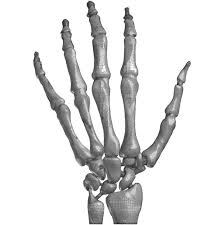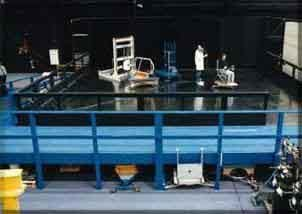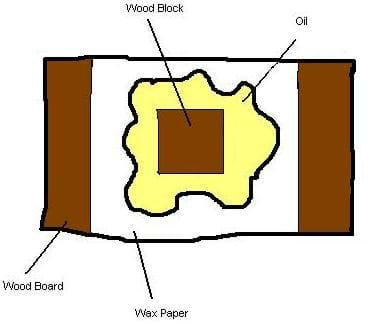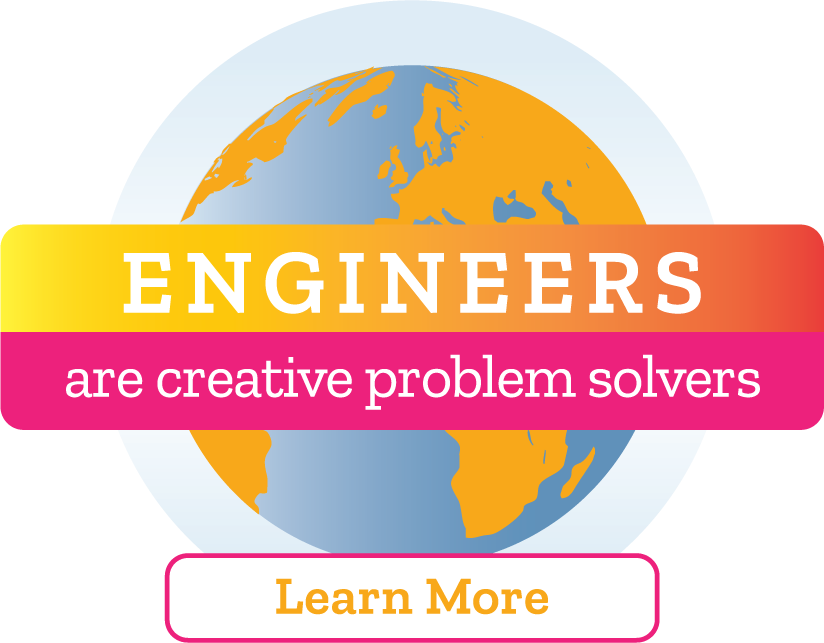Quick Look
Grade Level: 5 (3-5)
Time Required: 45 minutes
Expendable Cost/Group: US $2.00
Group Size: 2
Activity Dependency: None
Subject Areas: Biology
NGSS Performance Expectations:

| 3-PS2-1 |
Summary
Students use wood, wax paper and oil to investigate the importance of lubrication between materials and to understand the concept of friction. Using wax paper and oil placed between pieces of wood, the function of lubricants between materials is illustrated. Students extend their understanding of friction to bones and joints in the skeletal system and become aware of what engineers can do to help reduce friction in the human body as well as in machines.
Engineering Connection
Many machines that engineers design use joints similar to the ones found in our bodies. Both the joints in machines and the joints in our bodies are susceptible to friction. Our bodies use synovial fluid to reduce friction, and machines use lubricating fluids for the same purpose. Astronauts have some special challenges due to the lack of friction in outer space.
Learning Objectives
After this activity, students should be able to:
- Define and describe friction in everyday life.
- Relate friction to bones and joints in the human body.
- Explain what the human body and engineers do to reduce friction.
- Describe how the astronauts learn to work without friction in outer space.
Educational Standards
Each TeachEngineering lesson or activity is correlated to one or more K-12 science,
technology, engineering or math (STEM) educational standards.
All 100,000+ K-12 STEM standards covered in TeachEngineering are collected, maintained and packaged by the Achievement Standards Network (ASN),
a project of D2L (www.achievementstandards.org).
In the ASN, standards are hierarchically structured: first by source; e.g., by state; within source by type; e.g., science or mathematics;
within type by subtype, then by grade, etc.
Each TeachEngineering lesson or activity is correlated to one or more K-12 science, technology, engineering or math (STEM) educational standards.
All 100,000+ K-12 STEM standards covered in TeachEngineering are collected, maintained and packaged by the Achievement Standards Network (ASN), a project of D2L (www.achievementstandards.org).
In the ASN, standards are hierarchically structured: first by source; e.g., by state; within source by type; e.g., science or mathematics; within type by subtype, then by grade, etc.
NGSS: Next Generation Science Standards - Science
| NGSS Performance Expectation | ||
|---|---|---|
|
3-PS2-1. Plan and conduct an investigation to provide evidence of the effects of balanced and unbalanced forces on the motion of an object. (Grade 3) Do you agree with this alignment? |
||
| Click to view other curriculum aligned to this Performance Expectation | ||
| This activity focuses on the following Three Dimensional Learning aspects of NGSS: | ||
| Science & Engineering Practices | Disciplinary Core Ideas | Crosscutting Concepts |
| Plan and conduct an investigation collaboratively to produce data to serve as the basis for evidence, using fair tests in which variables are controlled and the number of trials considered. Alignment agreement: Science investigations use a variety of methods, tools, and techniques.Alignment agreement: | Each force acts on one particular object and has both strength and a direction. An object at rest typically has multiple forces acting on it, but they add to give zero net force on the object. Forces that do not sum to zero can cause changes in the object's speed or direction of motion. (Boundary: Qualitative and conceptual, but not quantitative addition of forces are used at this level.) Alignment agreement: Objects in contact exert forces on each other.Alignment agreement: | Cause and effect relationships are routinely identified. Alignment agreement: |
International Technology and Engineering Educators Association - Technology
-
Technological advances have made it possible to create new devices, to repair or replace certain parts of the body, and to provide a means for mobility.
(Grades
3 -
5)
More Details
Do you agree with this alignment?
-
Describe the properties of different materials.
(Grades
3 -
5)
More Details
Do you agree with this alignment?
State Standards
Colorado - Science
-
Assess further scientific explanations regarding basic human body system functions
(Grade
5)
More Details
Do you agree with this alignment?
-
Create and evaluate models of human body systems and organs
(Grade
5)
More Details
Do you agree with this alignment?
Materials List
Each group needs:
- 1 wood block (small size)
- 1 wood board (at least longer than the wood block)
- 2-3 paper towels
- 1 square of waxed paper (enough to cover each of the wooden block and board)
- 2 copies of the Joint Worksheet
- Pictures of human joints
To share with the entire class:
- Vegetable cooking oil
- Cellophane tape
- Scissors
Worksheets and Attachments
Visit [www.teachengineering.org/activities/view/cub_human_lesson03_activity1] to print or download.Introduction/Motivation
Does anyone know what friction is? (Take answers from the class.) Friction is a force that is created when two things rub together. Rub your two hands together. Hear the noise that your hands make? That noise is friction. Friction resists motion, and can make it hard to push one object over, or next to, another object. Think about sliding on the floor in your socks — is it easier to slide across a tile floor or a carpeted floor? Well, a carpeted floor has more friction, making it harder to slide around in your socks. Friction can lead to wear and tear by slowly wearing material down over time. There are a lot of places that friction occurs: two of those places are in machines and in our bodies.
Here on Earth, friction can cause problems by wearing down machines. For example, when you frequently ride a skateboard, you wear down the wheels of the skateboard and have to replace them (because the wheels constantly roll over cement or other surfaces, causing friction which then causes wear). Do you think friction can wear down the bones in our bodies? It certainly can! The same way wheels wear down after continual use on pavement.
One place that friction affects our bodies most is in our joints. There are many different types of joints in the human body, but today we are going to learn about just three: ball and socket joint, hinge joint and sliding joint. Your elbows and knees are hinge joints; they move in one direction like hinges on a door. Your shoulder is a good example of a ball and socket joint. It can move in all directions. Make a fist with your right hand and put it into your left open hand. Now move it all around. (Note: teacher should demonstrate.) That is how a ball and socket joint works. Sliding joints move in small sliding motions like rubbing your hands together. You can find these in your hands and feet.
These joints all have something in common ─ they are called synovial joints, which means that they have a cavity in the joints that contains synovial fluid. Joints are not just made of bone, because if they were, friction would keep them from moving smoothly. The body uses cartilage and the synovial fluid to reduce friction in joints. Osteoarthritis happens when cartilage wears away over time and exposes bone to bone and increases friction, which is very painful.
In outer space, astronauts have to deal with another problem altogether – the lack of friction! Because there is almost no gravity in outer space, there are less friction forces. This means that you can push a very heavy object, and, since it has much less friction to slow it down, it will just keep going and going! If you kick a soccer ball in space, it does not slow to a stop, it just keeps rolling forever. This lack of friction can make it difficult for astronauts to work on the space station or on space shuttles. Since astronauts are not used to working without friction, they have a special place at NASA where they can experience what a frictionless environment feels like.
This special frictionless environment is called the Precision Air-Bearing Facility (PABF), and it is like a huge air hockey table (see Figure 1). It is a big, smooth, metal floor with very large objects placed on the floor. Air is then pushed out from each of the objects' bottom edges, causing them to hover just a little bit above the floor ─ similar to an air hockey puck. The astronauts practice pushing these large objects around, helping them learn how to guide and direct objects in outer space.

Engineers can learn a lot about how to design machines by studying the human body. Many machines that engineers have designed use these three types of joints: ball and socket, hinge, and sliding, just like the body does. Engineers also use oil to create a barrier between two surfaces to reduce friction ─ just as the body uses synovial fluid to reduce friction. Biomechanical engineers, who work with helping people who have been injured, can design new bones for the human body and help reduce friction of joints that are rubbing together and causing pain. Today, we are going to learn a little more about friction and how it relates to joints in our bodies. We are going to look at waxed paper and compare that to cartilage. Then, we are going to compare cooking oil to synovial fluid. Let's go!
Procedure
Before the Activity
- Gather all necessary materials.
- Obtain pictures of human joints from the library or internet (http://ovrt.nist.gov/projects/vrml/h-anim/jointInfo.html).
With the Students
- Discuss the following different kinds of joints and location in the body.
- Ball and socket joint: located in the hip and shoulder; connection between ball-shaped and cup-shaped bones. The ball can twist in many directions and is very flexible.
- Hinge joint: found in the elbow and knee; bones fit together so that movement in only one plane is possible. This is the least flexible joint.
- Sliding joint: located in the feet and hands; flat surfaces of bones slide over each other rather than rotating about an axis.
- Examine pictures of joints from library or internet resources. Have students draw an example of each joint on their Joint Worksheet.
- Have students rank the joints in terms of flexibility. Use " < " to show increasing flexibility (i.e., Hinge < Sliding < Ball and socket) or " > " to show decreasing flexibility (i.e., Ball and socket > Sliding > Hinge).
- Students should rub the wood block along the wood board. The students will feel friction. Define friction to the students as a force that resists motion.
- Ask students to give different examples of friction and list their responses on the board. (Possible answers: socks against carpet, brakes on the car, skateboard on pavement/concrete, tires on the road, etc.) Explain that joints would have friction if they rubbed against each other. Ask the students if they know what osteoarthritis is, and then explain how a person develops osteoarthritis. (Answer: Their cartilage wears away, and bone rubs against bone.)
- So how is friction reduced? Engineers use oil to create a barrier between two surfaces to reduce friction. The body uses cartilage and a fluid, called synovial fluid, to reduce friction in joints.
- Have the students wrap both wood surfaces with waxed paper and tape it down. Then have the students rub the surfaces together. What happens? (Answer: The wood slides more easily, friction is reduced.) The waxed paper acts like cartilage.
- Now add a little cooking oil to the waxed paper on the wood board (remind students to be careful, as the paper is slick and the oil will run very easily). Have the students rub the block along the board again. What happened? (Answer: Friction is reduced even further.) This represents the synovial fluid.
- Discuss with students how friction can wear down bones and joints over time. What could engineers do to help reduce friction in artificial limbs? (Answer: Engineers could develop fluids and surfaces to help reduce the friction in artificial bones and joints.)
- Engineers who work for NASA are figuring out the best ways to help the astronauts have healthy bones and joints while they travel in space. Have the students brainstorm ways to help astronauts move around in a frictionless environment.
Vocabulary/Definitions
Ball and Socket: A joint in which a ball moves within a socket (such as in the hip).
Cartilage: A usually translucent somewhat elastic tissue.
Friction: The force that resists relative motion between two bodies in contact.
Hinge joint: A joint that only allows motion in one plane.
Osteoarthritis: A condition where the cartilage in joints wears away and allows bone to rub against bone, causing friction and, oftentimes, pain.
PABF (Precision Air-Bearing Facility): A special floor that NASA uses to help astronauts learn how to work without friction; similar concept as an air hockey table.
Sliding joint: A joint where the opposing surfaces are nearly planes; one that allows sliding or gliding motion.
Synovial fluid: A lubricating fluid secreted by your body.
Assessment
Pre-Activity Assessment
Question/Answer: Ask students questions and have them raise their hands to respond. Write answers on the board and discuss as a class.
- Have students push on a heavy object (such as the teacher's desk). Ask students what is balancing the force they exert on the desk. (Answer: Friction force balances the force they put on the desk.)
- Ask students what will happen if the force they exert on the desk becomes unbalanced with the friction force between the desk and the floor. (Answer: The desk will start moving.)
- Ask students to try to define friction. (Answer: The force that resists relative motion between two bodies in contact.) Have them give words that would describe friction. Write these words on the board. Work through the discussion with them until the class comes up with a good definition.
- Ask students if friction is a good thing or a bad thing; discuss as a class. (Answer: It is both good and bad! It is great for slowing things down, but it can also cause wear and tear in our bodies and in machines.)
- As a class, brainstorm ideas to reduce friction between the desk and the floor. Have students plan a way to reduce this friction. (One possible solution: Pour cooking oil on the floor beneath the desk.)
Activity Embedded Assessment
Figure Drawing: Have the students draw a diagram of the wood board and block, wax paper and oil. Encourage them to label all the parts. (See Figure 2).

Worksheet / Pairs Check: Have students work individually or in pairs on the Joint Worksheet. After students finish the worksheet, have them compare answers with a peer or another pair, giving all students time to finish the worksheet.
Post-Activity Assessment
Friction Bingo: Provide each student with a sheet of paper containing a list of the following vocabulary terms. Have each student walk around the room and find a student who can define one vocabulary term. Students must find a different student for each term. When a student has all terms completed s/he shouts "Bingo!" Continue until two or three students get a "bingo."
- Vocabulary terms to use: friction, synovial fluid, hinge joint, ball and socket joint, sliding joint, cartilage, osteoarthritis, PABF, lubrication.
- Ask students to predict what would happen if the force they exert on the desk and the friction forces become unbalanced by reducing the friction. (Answer: The desk will begin to slide.)
Troubleshooting Tips
This activity is messy! Consider covering the tables with newspaper beforehand, and having paper towels ready for spills.
If waxed paper is not available, try using aluminum foil instead.
Remind students to be careful when the vegetable oil is poured onto the waxed paper, as it will run very easily (and quickly) causing even more of a mess!
Activity Extensions
The Society of Women Engineer's has a great activity in which students create a model arm and shoulder, looking at biomechanics and sports performance. The website for this is: http://www.swe.org/iac/LP/biomed_03.html
Have students research different engineering applications that use lubrication to reduce friction.
Ask students to design another way that NASA could create a frictionless environment in which the astronauts could train for travel to outer space.
Activity Scaling
- For older students, discuss how friction over time affects the maintenance costs associated with a machine. (For example, friction on car tires wears down their treads, and they eventually need to be replaced.)
- For younger students, discuss friction as the rubbing of two objects. Have them complete the activity and discuss how friction in bones could be bad for the skeletal system.
Subscribe
Get the inside scoop on all things TeachEngineering such as new site features, curriculum updates, video releases, and more by signing up for our newsletter!More Curriculum Like This

This lesson covers the topic of human bones and joints. Students learn about the skeleton, the number of and types of bones in the body, and how outer space affects astronauts' bones. Students also learn how to take care of their bones here on Earth to prevent osteoporosis ─ or weakening of the bone...

Students extend their knowledge of the skeletal system to biomedical engineering design, specifically the concept of artificial limbs and joints. Students relate the skeleton as a structural system, focusing on the leg as structural necessity. They learn about the design considerations involved in t...

Students learn about the function and components of the human nervous system, which helps them understand the purpose of our brains, spinal cords, nerves and five senses. In addition, how the nervous system is affected during spaceflight is also discussed.
References
Canright, Shelly. National Aeronautics and Space Administration, For Students (Grades 5-8), Features and News, "Astronauts in Training," May 27, 2004.
Jones, J.R. National Aeronautics and Space Administration, Langley Research Center, "NASA Space Vehicle Design Criteria: Lubrication, Friction, and Wear," NASA SP-8063, June 1971.
National Aeronautics and Space Administration, Space Operations Missions Directorate, NASAExplores, Express Lessons and Online Resources, "Two-Ton Hockey Pucks," November 12, 2003. http://ms.spacegrant.org/uploads/images/Education/Conferences/NASA%20s%20Toy%20Box/2.ton.hockey.pucks.pdf
Parker, Steve. How the Body Works, London: Dorling Kindersley Limited, 1994.
Ressler, Sandy. National Institute of Standards and Technology, Visualization and Usability Group, OVRT Resources for the Humanoid Animation Working Group.
University of British Columbia, Department of Zoology, "Al's Website," http://www.zoology.ubc.ca/~biomania/tutorial/bonejt/anc07.htm
U.S. Department of Health and Human Services, National Institutes of Health, National Institute on Aging, Health Information, Publications, "Age Page: Arthritis Advice," May 2005.
Copyright
© 2006 by Regents of the University of Colorado.Contributors
Jessica Todd; Sara Born; Abigail Watrous; Denali Lander; Beth Myers; Malinda Schaefer Zarske; Janet YowellSupporting Program
Integrated Teaching and Learning Program, College of Engineering, University of Colorado BoulderAcknowledgements
The contents of this digital library curriculum were developed under a grant from the Fund for the Improvement of Postsecondary Education (FIPSE), U.S. Department of Education and National Science Foundation GK-12 grant no. 0338326. However, these contents do not necessarily represent the policies of the Department of Education or National Science Foundation, and you should not assume endorsement by the federal government.
Last modified: May 11, 2022






User Comments & Tips